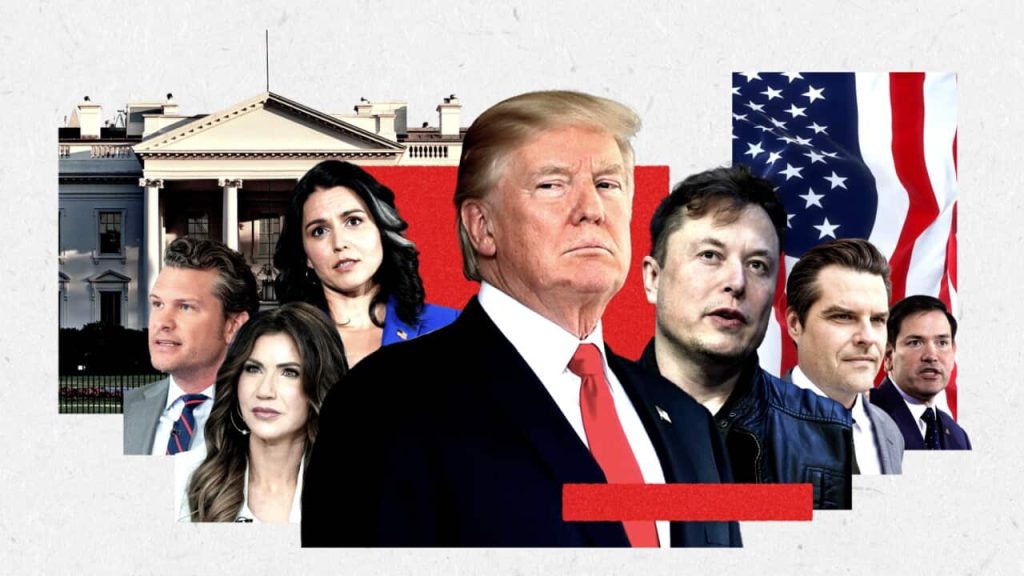Prior to his inauguration as President of the United States in January, Donald Trump has been unveiling his selections for cabinet positions, high-ranking government officials, and key policy advisers.
While some of Trump’s appointees bring years of political experience to the table, such as Florida senator Marco Rubio and former Arkansas governor Mike Huckabee, others, like the and Fox News host Pete Hegseth, have never held elected office.
Most notably, Trump recently announced that Robert F. Kennedy Jr. would be taking on the role of Secretary of Health and Human Services in his administration.
Let’s delve into the individuals who have been selected so far, and explore the reasons why, unlike in Australia, individuals leading key departments that influence US policy are not elected members of parliament.
The US Cabinet and Its Responsibilities
The US cabinet, which advises the President, consists of the Vice President and the heads of 15 executive departments, including:
- Secretary of State
- Secretary of the Treasury
- Secretary of Defense
- Attorney General
- Secretary of the Interior
- Secretary of Agriculture
- Secretary of Commerce
- Secretary of Labor
- Secretary of Health and Human Services
- Secretary of Housing and Urban Development
- Secretary of Transportation
- Secretary of Energy
- Secretary of Education
- Secretary of Veterans Affairs
- Secretary of Homeland Security
Following the President and Vice President, cabinet members are among the highest-ranking officials in the US government, often serving as the President’s closest advisers and confidants.
Cabinet secretaries, along with the Vice President, are also part of the presidential line of succession.
The President has the authority to elevate other high-ranking officials to cabinet level, although they are not included in the line of succession.
For example, in the Biden administration, individuals like the White House Chief of Staff, the US Ambassador to the United Nations, and the Director of National Intelligence hold cabinet-level positions but are not in the line of succession.
The Selection Process for US Cabinet Members
Unlike Australia, where the Prime Minister can only select cabinet members from elected government officials in the Senate and House of Representatives, there are fewer restrictions on whom the US President can appoint to the cabinet.
Dual service in both the executive and legislative branches of government simultaneously is prohibited in the US.
If a Senator or House of Representatives member is chosen for a cabinet position, they must resign from Congress.
Immediate family members of the President are also ineligible for cabinet positions.
Individuals born outside the US or under the age of 35 can serve in the cabinet but cannot be part of the presidential line of succession.
Cabinet and cabinet-level appointees undergo extensive background checks by the Federal Bureau of Investigation, and Senate approval is required for most of these appointments.
With Republicans holding a majority in the Senate, Trump’s cabinet picks are expected to face minimal opposition during the confirmation process.
Trump’s Selections for Cabinet and Key Roles
Instead of opting for experienced professionals, Trump has chosen individuals who are loyal to him and aligned with his policy goals.
Despite lacking prior elected office experience, Fox News host and military veteran Pete Hegseth has been nominated by Trump for the position of Secretary of Defense.
Hegseth’s involvement in National Guard duty for Joe Biden’s inauguration was halted due to his ties to right-wing militia groups and extremist online postings.
Robert F. Kennedy Jr., who has faced criticism for his vaccine skepticism, ran for president as an independent before endorsing Trump in exchange for a cabinet role as Secretary of Health and Human Services.
While RFK Jr. denies being anti-vaccine, his leadership of the Children’s Health Defense organization, known for its anti-vaccine stance, has raised concerns.
Congressman Matt Gaetz’s nomination as Attorney General stirred controversy due to an ongoing House ethics probe into alleged sex trafficking, although the Justice Department previously decided not to press charges in a related case.
If approved, Marco Rubio would be the first Latino Secretary of State, focusing on intensifying US-China power dynamics, advocating for Israel, and criticizing Russian President Vladimir Putin.
Mike Waltz, a former special forces officer, is Trump’s pick for National Security Adviser, emphasizing threats posed by China and Russia while supporting reduced aid to Ukraine.
Kristi Noem, the South Dakota governor, is expected to play a vital role in immigration policies as Secretary of Homeland Security, known for her controversial stance on COVID-19 restrictions.
Tom Homan, a veteran immigration official and Heritage Foundation fellow, has been appointed as ‘border czar’ to oversee Trump’s deportation initiatives.
Tulsi Gabbard, a former Hawaii congresswoman and Iraq war veteran, is Trump’s choice for Director of National Intelligence, known for her isolationist foreign policy views and past endorsements of Trump.
John Ratcliffe, former Director of National Intelligence, has been nominated to lead the Central Intelligence Agency, recognized for his defense of Trump during impeachment proceedings and his institutionalist approach.
Elon Musk, the world’s richest man, and Vivek Ramaswamy are expected to play influential roles in Trump’s administration, focusing on budget cuts and policy implementation.
Liz Cheney, a prominent Republican, will serve as the first female Secretary of Defense, while Mike Huckabee, former Arkansas governor, is set to become the US Ambassador to Israel.
Report compiled with information from Agence France-Presse

